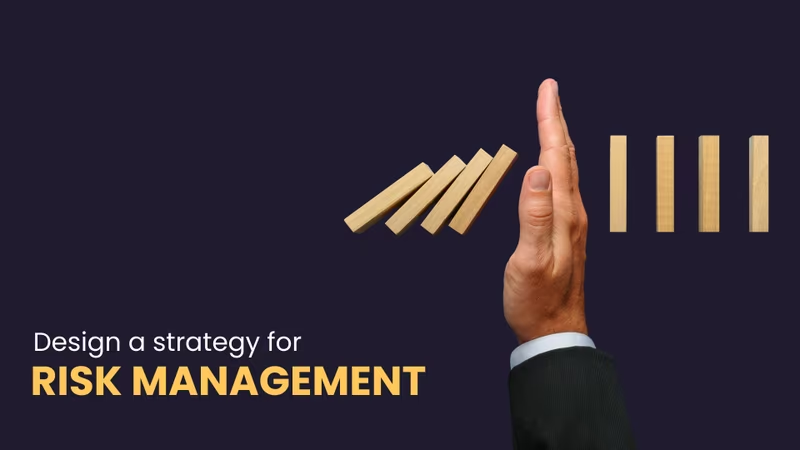As an adult, juggling a healthy lifestyle, trying to keep up your social circle all the while ensuring that your finances do not take a tip can be taxing. Which is why tax saving investment options are important for you
Going about this routine, every day of every week might make you question if there’s a financial mantra that can help you achieve your financial objectives. Well, guess what – you can!
But, that’s only possible if you avoid the following three things: inflation, taxes, and risk. Inflation can be predicted and taxes reduced with relative ease, but the risk is more difficult to foresee since it is so unexpected.
The probability of suffering a loss is referred to as the "risk." Sometimes the loss is inconsequential, but other times it might result in significant personal and financial difficulties.
While there's no scenario that can eliminate risks 100%, there are steps in the risk management process that you can take to prevent, limit, or protect yourself and your home and family from it.
When the danger is minor or the price is not prohibitively high, it is simple to accept the risk. When taking risks is prohibitively expensive, you must find an alternative means of managing them.
So, how do you figure out the fundamentals of risk management and how to create risk strategies that align with your plan, let’s find this out and more in this blog.
Understanding what risk management is:
In simple terms, risk management entails the process of analyzing and interpreting, accepting, or mitigating uncertainty in investment choices in the financial sector.
So, risk management is the process where as an investor or fund manager, you analyze the possibility of losses in an investment and then take the right action (or inaction) in accordance with the investment goals and risk tolerance.
Companies tend to connect risk management with major organizations because of its critical role. Personal financial planning, on the other hand, demands just as much attention to risk management.
So, what is the significance of a risk management plan, and how can it be mitigated in both company and personal finances? In order to understand risk management, let's first take a closer look at what it actually is:
What qualifies as managing risk?
The definition of risk management tells us that it is a way to reduce the negative effects of potential risks and uncertainties on an organization's operations.
In layman's terms, this involves devising a plan to guard against financial loss in the event of unforeseen circumstances.
A succession plan in corporate finance might be implemented in the event that an important company stakeholder is no longer capable of performing their tasks.
It's important to plan for a variety of events that might lead to financial difficulties in personal finance. We're dealing with a risk management framework here.
It is essential to safeguard your ambitions, dreams, wealth, and well-being against the "what ifs" of life through effective personal risk management strategies and practices.
Risk tolerance varies from individual to individual based on spending
Based on income, risk management can differ considerably. If you receive a certain amount of income based on contracts, then managing that can be easier compared to individuals who have taken on debts or loans.
Also, risk factors increase when income increases, and finding a way to safeguard against the same is crucial in managing finances in the event of an emergency.
The risk may also be described as either an income risk or a cost risk. Just as the term indicates, income risk impacts your capacity to create an income.
Specific instances of income risk include mortality, loss of job, underemployment, getting disabled resulting in an incapacity to work, and, for seniors, outliving your income-producing assets.
Expense risk is significantly more difficult but is simply the assumption that you will spend even more money than you now have. This might be voluntary or involuntary.
For example, elective cost risk would be overspending or spending more money than you make, whereas involuntary expense risk happens when an emergency compels you to spend money.
Oftentimes, an income risk might lead to an expense risk. You may also not be generating enough money to satisfy your requirements, a hallmark of poverty.
Curbing risks on investment requires creating a decisive plan and these six methods of effective risk management can help you, in the long run, to save money and mitigate losses:
Risk retainment
One accepts a certain risk or hazard and is prepared to deal with it on their own if necessary. It's best to know how much harm or financial loss you'll endure if the worst happens if you decide to employ risk retention as your risk management strategy. The next stage is to devise a backup plan in case the worst happens.
For example, you may elect not to insure your high-priced laptop or cell phone. If your current device is lost or damaged, you're on the hook for the cost of a replacement. We suggest that you start parking your money for this one from now in case you have to pay for this expenditure.
Risk avoidance
While there are multiple ways you can shield yourself from being exposed to danger, risk avoidance is one of the most important. Because risks cannot be completely eliminated, this approach focuses on reducing the likelihood of being exposed to a hazard.
For example, you may avoid some regions because of their high level of insecurity. Or you take a different route since the other has a high crime rate to your desired location. Similarly, investing in some companies or assets in finance isn't worth it since the returns aren't worth the risks.
Risk reduction
In order to reduce the overall impact of the risk you could be exposed to in a specific circumstance, you must follow procedures that allow you to do so. You may avoid late fees and penalties by regularly reviewing your financial statements.
Additionally, you may boost your home's protection by putting up security equipment. It is possible to have an exit strategy in place for your investments, such as liquidating an investment if the loss exceeds a certain percentage, so that you do not lose all of your investment.
Risk sharing
There are some situations when you don't have to endure the full brunt of the financial consequences of a risk. The risk-sharing or risk-distribution mechanism is useful in this situation. Insurers and other risk-sharers can help you spread the cost of a possible loss.
Because of this, when someone purchases an insurance policy, they're giving up part of their own risk, which in turn is shared with other people.
As a result, a number of people and groups come together to seek protection from insurance against similar dangers. In return for this insurance, you merely pay monthly premiums.
There is a pool of people for which you pay premiums if you have vehicle insurance in the event of an accident. You will be compensated from this fund if you are involved in an accident.
Risk anticipation
Understanding future risk can also help you make changes to your current policies and investments in the present. Create a risk anticipation strategy that allows you to protect your money in case it falls beyond a particular amount. Create stop-limits to cut your losses beforehand so you don't freefall in case of a market crash later on.
Always have a risk anticipation strategy in hand so that you're able to keep templates for five, or even ten years ahead. This way, you'll never face the issue of losing a lot of money in case of a dire financial calamity.
Risk information sharing
Once you've created a robust risk management technique and strategy, it's time to share it with the ones you trust. You do this because they can also share their risk management steps with you. By doing this, you can take notes from their strategies and see if they can improve yours.
Since it's a long-term strategy, always keep talking and transferring knowledge between yourself and investment leaders. By doing so, you might stumble upon a risk management principle that might be better than yours and help save more money.
Is risk management important? Factors to consider before designing a risk management strategy:
Defining the right goals
Goals and risks must be clearly defined if you want to avoid wasting time and energy on things that aren't important to you.
Identifying possible hazards requires a well-defined set of objectives. Take into account not just the current situation but also possible future circumstances in order to detect these dangers.
Even though it appears implausible, you should never disregard the possibility of a major event having significant consequences.
Identifying and mitigating potential risks
In risk management, one of the most important ideas is to assess all possible outcomes. This is at odds with our cultural norms, which discourage discussing poor outcomes or "bad news."
Even if we know the worst-case scenario, there is no way to plan ahead to avoid it. It's quite important to have a contingency plan in place in case a potential risk scenario comes to fruition.
Decision-making abilities
In order to effectively manage risks, the most important step is to carry out the necessary activities. Even if no danger can be completely avoided, you should devote as much time and energy as possible to finding solutions to minimize the harm they may do.
There may not always be time to prepare for hazards that arise unexpectedly, so increasing your decision-making skills and risk thinking is necessary if you want to be resilient and adjust quickly to changing circumstances.
Following a risk management strategy will lead to success
The actions and strategies listed above goes a long way towards coping with uncertainty.
The ability to forecast the future and plan for everything in advance may be extremely challenging during times of uncertainty and rapid change.
However, this doesn't eliminate the need to consider potential hazards in the planning process.
Preparing for every conceivable scenario and deciding on the best course of action makes it simpler to deal with any unexpected changes in the environment.
Financial risk mitigation plans that are more sensitive to shifting trends may be developed with more risk awareness and educated decision-making.
Follow the right steps, identify areas that need improvement, and slowly build your wealth. Remember, this is a long-term game, and you need the patience to be successful.
Stay calm and continue focusing on the process of getting the risk management strategy right, and you'll soon notice how well your portfolio is primed against all types of risk.










